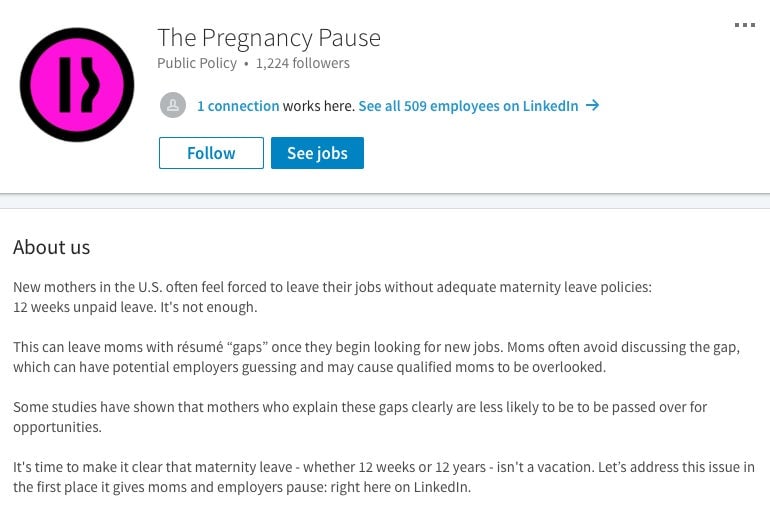Staying home with kids is a job. So how does it fit on a resume?
Staying at home to raise a child is very much a full-time job, as anyone who’s done it or seen it up close can attest. Once a parent who has stepped out of the workforce is ready to step back in, however, finding the right words to describe that time at home to a potential employer can be a tricky prospect.


Staying at home to raise a child is very much a full-time job, as anyone who’s done it or seen it up close can attest. Once a parent who has stepped out of the workforce is ready to step back in, however, finding the right words to describe that time at home to a potential employer can be a tricky prospect.
When it comes to addressing a prolonged period of caregiving on a resume or LinkedIn, some people opt to put their parental duties upfront. That’s the idea behind the Pregnancy Pause, a free toolkit of resume templates that help current or former stay-at-home parents craft job descriptions around the work of raising a family. The Pregnancy Pause is also set up as its own company on LinkedIn, where some 500 people currently cite job descriptions ranging from “Mom” to “Domestic Engineer.”

The toolkit was launched in May 2017 by New York-based advertising agency Mother.
“I am outraged by the US maternity policy, or the lack of it, to be precise,” said Corinna Falusi, partner and chief creative officer at Mother.
The dearth of paid parental leave in the US means that leaving the workforce is the sole option for many parents who want to be home with their children for any length of time, Falusi said. The company created the toolkit as a free service to parents who want to mark the time on their public profiles in a way that acknowledges the full-time work of raising a child, rather than dancing around it.
The Pregnancy Pause is far from a perfect solution. Between the name and the bright pink logo echoing the silhouette of a pregnant woman, it’s not very accommodating of fathers, adoptive parents, or other parents for whom pregnancy doesn’t apply. (Falusi acknowledges that, and says that future iterations of the site will be more inclusive.) In some cases, it may even be counterproductive once an active job search is underway.
“Should you list your current job as ‘stay-at-home mom’? I vote no. It’s hard for me to say this, because I want the answer to be yes,” said Jenny Foss, a career consultant and author of the JobJenny blog.
As a mother of three, Foss is well aware of the demands of full-time parenthood. Yet she’s also conscious of the fact that the hiring managers reading those resumes have biases and assumptions of their own. Applicants who lead with their parenting chops may be inadvertently discounting more relevant experience.
“Here’s what can happen: you could give the impression that you’re making light of a ‘professional career.’ Or, if that resume lands in the hands of a female hiring manager who is juggling the demands of being a parent and a corporate leader, she may be resentful that you’re listing out what she’s doing on top of her day job as your full-time job,” Foss wrote to Quartz At Work in an email. “Also, if your potential future boss is even a bit sexist, he may eye-roll at the treatment of ‘Mom’ as a listed job on a resume. (Yes, I know—do you want to work for that guy? Probably not.)”
Pam Lassiter, a career consultant who specializes in women’s re-entry to the workforce, agreed. “Companies don’t care too much that you’ve stayed home with your kids,” she said. “They care about how you’re going to be profitable for me tomorrow.”
That said, a period of time as a stay-at-home parent doesn’t have to stay a secret in a job interview or application. The key is to lead with the parts of the gig that are directly applicable to the industry you’re seeking to enter. Foss suggests a chronological resume that starts with an executive summary of skills and experience and then lists jobs in order, including any volunteer, part-time, or consulting work undertaken as a stay-at-home parent.
If family obligations have left a gap on your resume, feel free to address it—and then move on, Foss said.
“Say you’re a former marketing manager and you were off for seven years,” she said by way of example. “You’ve recently started helping the owner of the yoga studio down the street with social media and PR. List that as your current job and, right out of the gates, say, ‘Following a sabbatical to care for family, I accepted an opportunity to support this yoga studio in engaging new members and accelerating growth.'”
Crafting a resume is, obviously, only a first step in rejoining the workforce. Depending how long the pause has been, there may be larger challenges to consider, like getting up to speed with technological changes or rebuilding a network. But it’s not necessary to hide a job you did for love.
“The bottom line is if a company doesn’t want you because you’ve been home, it’s not the right company,” Lassiter said.